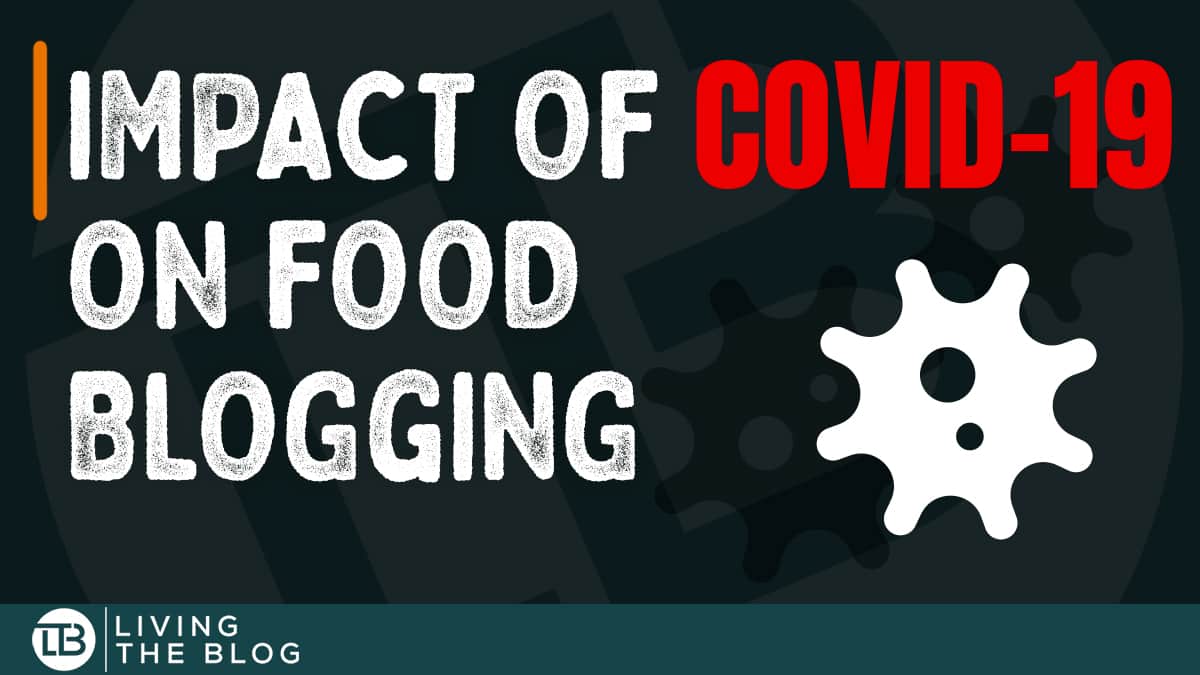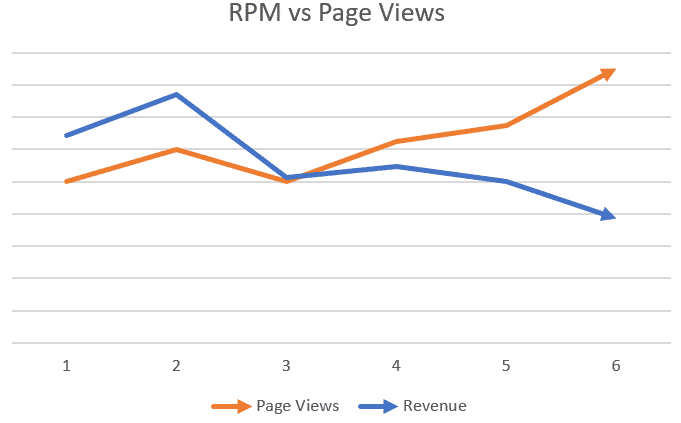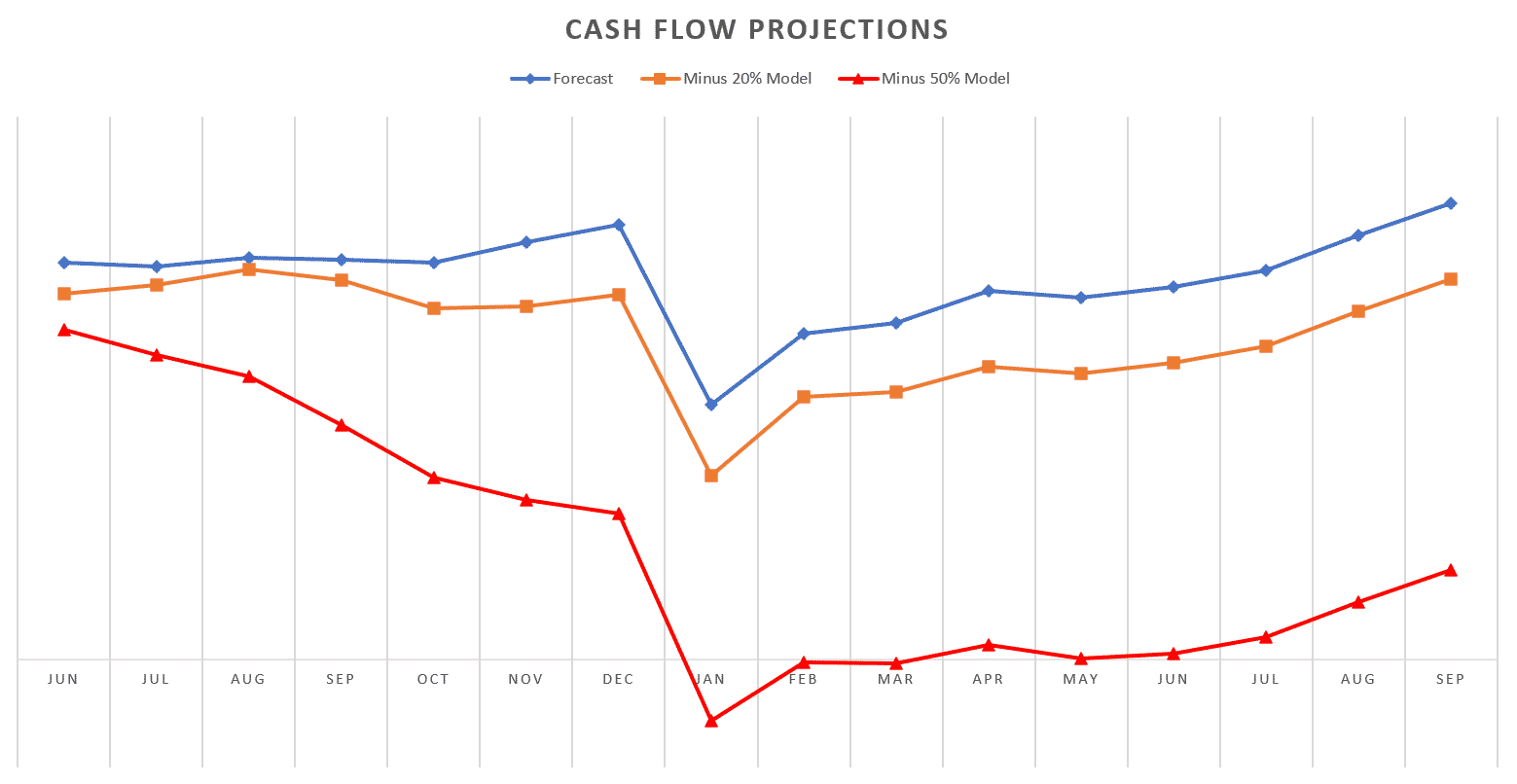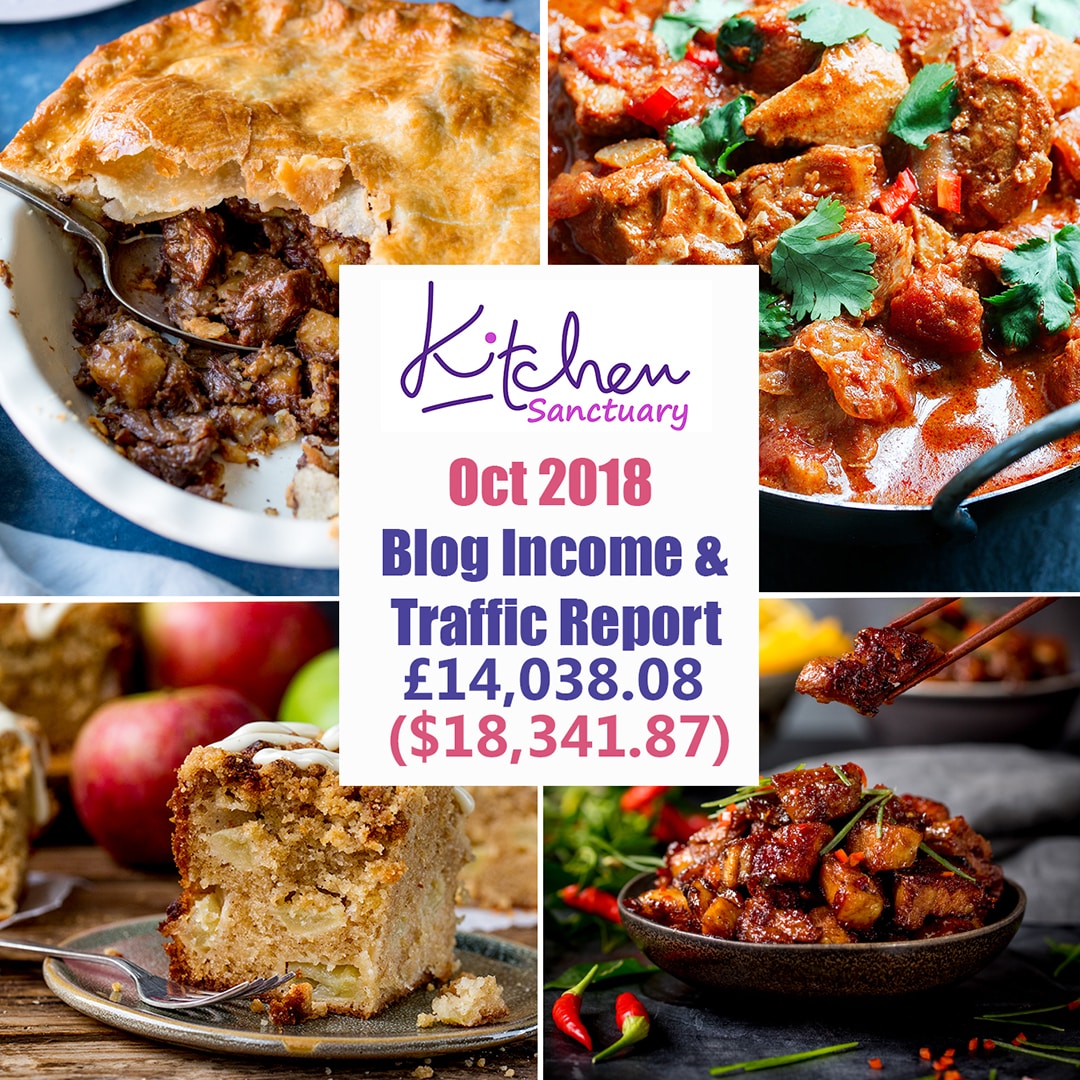A look at how we’re creating content in response to the impact of Coronavirus, what’s happening with blog income, and some ideas to help minimize revenue loss. 
First of all, how are you guys managing?
I hope you and your loved ones safe and well and you continue to be so.
Chris and I have been writing lots of foodie-based blog posts over at Kitchen Sanctuary to try to help our readers during the pandemic.
But what about you guys over here? You, our fellow bloggers who are trying to navigate through these challenging times whilst:
- Keeping your blog going,
- Possibly trying to maintain your sole or majority income,
- Probably being busier than ever,
- And, If you have kids, all while having a house full of noisy people who demand lots of attention and a ridiculous amount of snacks.
Like many of you, Chris and I rely on our blog as our full time income, So we wanted to share some of the things we’ve been looking at for Kitchen Sanctuary so see if they could help you.
Creating content in response to the impact of Coronavirus
Despite Coronavirus constantly being on everyone’s minds, ad companies have advised against talking directly about COVID-19 on our blogs. Many advertisers do reverse keyword targeting which means they have a list of keywords that they don’t want their advertisements to be shown near.
However, I think it’s important to acknowledge the situation in some way. Possibly in the types of posts you’re writing, or just checking in with readers every now and then on social media.
It’s important to be sympathetic to readers who may be going through a really bad time (now more than ever is a time to ignore negative comments!) and to be careful not to come across as opportunistic or unthinking.
It’s a bit of a balancing act, and I’ve found myself scrabbling to update social media posts that have gone out (posts that were scheduled in advance) that no longer sound appropriate.
Here’re some of the things we’ve been doing that appear to be going well:
Helpful posts:
- Round ups –We’ve been scouring through our content in order to pull together relevant lists to give readers plenty of ideas. These have included:
- Store-cupboard recipes
- Freezer recipes
- Cooking with kids
- Fakeaway ideas
- Making food go further (not yet live)
- Soups (not yet live)
These have gone down really well with our readers and we’ve been getting far more emails than usual, thanking us for ideas, asking questions, and generally opening up those lines of communication – which makes us so happy!
- Recipe Posts: Our content schedule is usually planned 2-3 months ahead and our completed content is usually created and scheduled around 4-5 weeks ahead. We’ve had to scramble to re-jig a number of posts and create or update recipes that we felt would be more helpful to our readers right now – such as:
We wrote the pasta how-to after getting comments from people who couldn’t find pasta in the shops.
It was written with lots of tips and some ingredient swaps etc. We still got some comments that readers couldn’t find any flour, but it did help those who could get hold of flour.
- Local businesses: We’ve kept this to social media only, but have been sharing info on local business whenever we see it, to help our community find the produce their looking for – such as restaurants offering delivery, farm-shop delivery boxes and milk vending machines. We do like to support local businesses when we can but now more than ever its super important to do this.
Other post ideas:
- How to make bread: We considered writing a new bread how-to, but ended up putting this on hold as it seems that yeast is also very hard to get hold of right now.
A no-yeast soft sandwich bread would be a great post, but I haven’t yet perfected the recipe! - Grow your own: It’s planting season and people are trying to keep themselves busy in the garden. Some ideas for growing your own, and what to make from your own produce could be very useful.
- Reducing waste: What to do with scraps and leftovers – potato skins crisps, ham bone-soup, spotty banana recipes – that’s great content at any time and could end up being good evergreen content for your site in the long term.
Don’t scramble to move away from your blogs main subject
Personally I don’t think pivoting your food blog completely in the face of the pandemic is a good idea. If your readers have an expectation of the types of recipes you write, try to look at how you can use existing content or write new posts relevant to your readers within your niche.
For example if you have a blog showing how to make fancy celebration cakes, perhaps you could simplify for the current situation – showing how to make THE BEST basic sponge, or how to get kids to make cake decorations from fondant icing.
Nasty comments:
Be prepared for nasty comments from stressed out people more than ever right now.
You can’t please everybody, not everybody can get hold of certain ingredients, people are rushed or distracted when cooking, and they like to take their stress out online. If it’s a comment that’s mean or rude just delete, ignore and don’t take it personally!
What’s happening with blog income
It’s a scary picture!

Brands seem to be cutting right back on sponsored, freelance and in some cases affiliate spend right now.
Apart from not wanting to appear insensitive, brands are worried about their own businesses – with concerns around stock levels, supply chain, staffing (working from home and staff illness) to name but a few. And companies in the food sector (particularly super markets) have cut ad spend as they don’t want to drum up any more demand at the moment. They simply don’t need to advertise.
Advertisers have also cut budgets – again they don’t want to seem insensitive and also have concerns regarding stock levels etc, but it’s also worth noting that different types of advertising have been impacted in different ways:
- Spend on advertisements for travel and live shows for example are way down.
- Spend on food advertisements are somewhat down (stock level/food shortage concerns).
- Whilst spend on technology and consumer packed goods (such as personal care and home care products) are up.
What this means is that there is less spend and less competition for the Ad spaces available, As a result of this RPM (Revenue Per Mille-or one thousand views) on ads is way down. It started to drop in March, and the beginning of Q2 saw a further drop. It’s pretty normal to see a drop in RPM at the beginning of any quarter, but ad companies told us to expect even further drops than usual, and boy are we seeing that 🙁
As an example, for Kitchen Sanctuary, we had an average RPM of $10.64 in March 2019, then $9.98 in April 2019 (note: most of our traffic is UK-based – which pays less than US-based ad revenue).
For March 2020 (bearing in mind RPM started to go down in mid March) our average RPM was $9.97. So far in April, our average RPM has been $6.08 and is still falling.
However, due to the fact that people are at home, our number of views has increased substantially. This appears to be the same for most food blogs. Which makes sense, as more people are cooking for themselves.
So overall, our ad revenue has stayed relatively stable so far. Of course this could all change at any time, but for now, we’re trying to ensure we don’t focus on the RPM, but instead just focus on overall ad revenue.
Digital ad spend is pretty agile, so we’re pretty confidant RPMs will bounce back as the lockdown starts to be lifted.
That’s not to say we’re just keeping our fingers crossed and hoping for the best though.
Spending years in the corporate world with a big focus on Business Continuity has taught us to to plan for contingency.
Contingency planning – Triggers and Actions
Chris and I recently walked through an exercise to go back and review our projected income on a month-by-month basis for the year. We typically do this at the beginning of every year and base the figures off average RPMs and projected blog growth (as well as any other projects we have planned) and use it as a rough guide. Given the current situation we felt we needed to sit down and rethink this.
During the exercise, we played around with the figures, looking at what would happen with reduced RPMs, increased pageviews, reduced brand work etc.
We found the simplest way to make a plan was to include figures (on a month-by-month basis) with:
- Current projections and income (that we’re already seeing – with high page views and low RPM)
- With a 30% reduction in income
- with a 50% reduction in income
The projections include lines for our expected outgoings (e.g hosting, payroll, courses, subscriptions, contractors, VA services, props, food, insurance, equipment, tax bill payments) so we can see at what point we’d be in trouble.

**Note: This chart dummy data – to illustrate the different projections**
The large dip in Jan shows when we pay our corporation tax. This is something you need to consider when doing your projections.
We also considered our outgoings in terms of:
- Cost (i.e we know that contractors, VA services and and equipment are fairly large outgoings for us)
- Outgoings we can’t eliminate/reduce (e.g hosting, tax)
- Outgoings we don’t want to eliminate/reduce, but could at a push (e.g contractors, subscriptions)
- Outgoings we that would be ok to eliminate/reduce for a while (e.g courses, new equipment < Chris is not happy with this one but he knows needs must at the moment)
This helped us to figure out our ‘trigger points’ for if-and-when we’d need to act, which makes decision-making easier if we actually get to a trigger point and have to take contingency measures.
For example if we hit a 30% reduction in revenue that lasts for more than 6 months, we’d hit a few tight spots over the coming months, and may have to stop/reduce spending on courses, subscriptions new equipment and possibly VA support.
If we hit a 50% reduction in revenue that lasts for more than 6 months, we’d find ourselves in much greater danger with the business. To limit the risk around this we’ve agreed trigger points as to when we’d have to reduce our outgoings. This is for illustration purposes only, but as an example:
- Immediately: We know that we don’t currently need any new equipment, so right away, we could stop any spend on that.
- 2 months in a row with a 50% reduction in income: this could be a trigger to reduce contractor services and courses, cut back our wages and reduce VA support.
- 3 months in a row with a 50% reduction in income: this could be a trigger to further reduce VA support, and to implement additional ways of bringing in income eg pitching for freelance work, selling some assets.
Modelling these scenarios with reduced income and subsequent reduced outgoings can help us to see at what point we would be in the red and what changes are most impactful in keeping us out of the red.
After looking at different projections and reducing outgoings where possible, our next step is to see where we could minimize revenue loss and where we could bring in additional income streams if needed.
Although its still a scary situation this exercise has really helped us be a little more calm and level headed about what’s to come and what we need to do.
Minimizing revenue loss
Some ideas on minimizing revenue loss:
- Videos in-post and on YouTube:
- Although general ad revenue is low, we’ve found that ad revenue from video on the blog and on YouTube is remaining pretty consistent. We usually post our videos to YouTube and embed the YouTube videos in the blog. We have some videos uploaded to our ad company, but not a huge amount.
As ad revenue is higher from automatic videos played via our ad company on the blog, we’re uploading more of our videos to our ad player and replacing the YouTube embed code with the ad company embed code. This is likely something we’ll only stick with temporarily as we’re trying to grow our YouTube channel (having the YT videos in our posts helps with that), and I would prefer not to have auto-playing video ads on the site in the long term (if we can afford to get rid of them at some point).
- Although general ad revenue is low, we’ve found that ad revenue from video on the blog and on YouTube is remaining pretty consistent. We usually post our videos to YouTube and embed the YouTube videos in the blog. We have some videos uploaded to our ad company, but not a huge amount.
- Review ad settings/categories:
- Do you know what ad categories you have set up on your site? There are some ad categories that we absolutely won’t allow on our site, but there are a couple that I’m on the fence about. It’s worth reviewing to see if you’d be comfortable enabling more ad categories if you’re comfortable with them.
- Number of ads:
- Got your number of ads set to low? Could you increase them a little without it upsetting your readers too much?
- Brand work:
- There’s not a lot of brand work going around at the moment, but do you have a good relationship with any brands? Particularly store-cupboard brands or kitchen equipment brands?
It could be worth reaching out to them to propose writing some sponsored content with them to help readers – such as store-cupboard recipes or tips for leftovers.
- There’s not a lot of brand work going around at the moment, but do you have a good relationship with any brands? Particularly store-cupboard brands or kitchen equipment brands?
Additional income streams
- Creating content for other blogs/websites:
- Freelance writing for other blogs or websites is a great way to earn a bit of extra cash. I’ve got a post on how to get freelance work that may help.
- Create an ebook:
- I’ve had more readers reaching out to me recently, asking if I have a book with all of my recipes in one place, or if I have an Asian recipes or a fakeaway recipe book. I’ve also had people asking if they can pay not to see ads on the site. Creating ebooks of categories of your existing recipes and charging a small fee could be a great way to earn a bit of extra income and to keep your readers happy.
- Patreon:
- Chris and I have been thinking about Patreon for a while. A number of YouTubers use it as a way to supplement their YouTube income, but it’s not just for YouTube. Patreon is a membership based platform that helps content creators to run a subscription-based service. Your Patreons pay a monthly fee (this could be tiered, based on your offerings) and they, typically, receive something in return. This may be something as simple as early access to your videos/recipes or exclusive recipes, ebooks or branded products. If you already have an engaged and supportive audience this could be an additional revenue stream for you to explore.
Do you have any more ideas for quick/easy additional income streams that might help food bloggers? Let me know and I’ll include in this post.
That’s about all I have for now, but here’s some further reading that might help:
- Financial resources for bloggers (this is an Adthrive post, it seems to be mostly US-based)
- COVID-19: support for businesses (UK GOV info) – Note: there doesn’t currently seem to be much help available to UK small limited company directors. See info from FTAdvisor for a summary.
- Coronavirus and digital media industry trends (3rd April 2020) – Adthrive
- COVID-19 & Mediavine updates
- COVID-19 content guidance for brands on Pinterest
- https://www.iab.com/insights/coronavirus-ad-spend-impact-buy-side/ (IAB – Interactive Advertising Bureau)
- and here’s Mediavine’s interpretation of it
In Summary
- Don’t focus on the RPMs. Look at the bigger picture (what are you earning over the week) and does that give you enough to live off.
- Do some maths and contingency planning, what would you do if your weekly income drops to a certain level.
- Do make sure your ads are optimised and get in touch with your ad company to see if they have any recommendations for maximising ad revenue for your site.
- Do look for other ways to supplement your income.
- Do continue to support your audience with content they expect from you.
- Do look for government help if you need it and it’s available to you.
- Do support one another, the food blogging community is a fantastic one and one we are proud to be a part of.
- Don’t give up – there will be light at the end of the tunnel.







Wow! This is fabulous and such a help to your fellow bloggers. Thank you to you both for your cheery upbeat attitude!